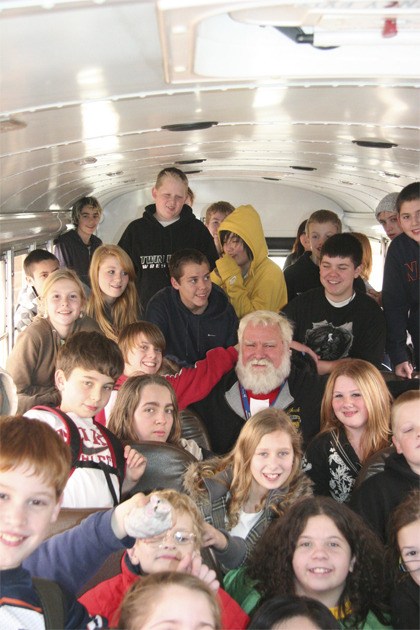Chuck Smith, a Snoqualmie Valley School District bus driver for the past three years, would drive his route for free if he had a choice.
“I’ve been through three big careers, and I wish I had started with this,” he said.
On his route, Smith is laid-back, but also takes time to get to know riders and ensure that they follow the rules.
“We’re mandated by law to take kids to school. Beyond that, you set the tone of the attitude of every child before they go to school,” he said. “If you show kids some compassion, you get it back ten-fold,” he said.
Smith’s department is one of dozens of aspects of Snoqualmie Valley School District that are directly funded by a perennial, four-year maintenance and operations levy. This year, the levy is up for renewal. Valley voters are asked to weigh in Feb. 9 on a $12.3 million package, replacing the expiring $9.9 million levy approved in 2006.
On the last day of school before Christmas break, Smith’s young passengers from Twin Falls Middle School and Opstad Elementary sent him off with holiday cards, hugs and carols.
“Middle school’s a tough age,” Smith said. “These kids have come a long way in their ability to get along with each other and me. There is not one day that goes by where I don’t look into the rear view mirror and feel an overwhelming sense of pride with each and every one of them.”
For Smith, it would be a shame for any election to shortchange their future.
“They’ve earned both my respect and vote.”
School impact
Levy funds augment the dollars that Valley schools receive from state and federal sources. Today, the maintenance levy provides nearly 20 percent of funding for daily operations.
Maintenance levy dollars touch student lives in dozens of ways, from school counselors who help guide young people’s choices to the custodians who clean buildings.
“The levy funds the most basic programs and needs in school district operation,” Snoqualmie Superintendent Joel Aune said.
School nurses such as Cathy Wolley, who covers several schools in the district, are also funded by levy dollars.
For Wolley, school nurses are necessary, especially for needy families.
“Students who do not come from high-functioning, strong families with good resources make my job important,” she said. “If a child is not healthy — physically, mentally, psychologically — they can’t begin to access the educational component of schools.”
Levies mean jobs. Of the 500 employees who work for Snoqualmie schools, about 65 percent live in the community. To Aune, education becomes the center of the community, with the biggest impact of levy dollars on the lives of students.
“It’s the students who have the whole road at stake when it comes to levies,” Aune said. “We’re obligated to provide the best school experience, but we also have a minimum level of revenue to get that job done.”
Levy package
Ranked 289 out of 295 school districts in the state of Washington, Snoqualmie has one of the lowest levels of funding per student. Districts such as Issaquah, Mercer Island and Bellevue have significantly higher funding per pupil, giving them the ability to ask their community for higher levy amounts.
The Snoqualmie district has historically sought to keep levies at the lid, or maximum amount, they can collect, roughly 25 percent of state and federal funding.
“We want to make sure the projected amount is at the lid amount,” Aune said. “Our district is growing. More students generate more needs and costs, and we want to make sure (funding) increases, so we can serve a growing student population.”
From 2007 to 2008, Snoqualmie schools saw a 1.8 percent increase in enrollment. Last year, enrollment jumped 2.4 percent. During the next four years, school officials expect a 4.5 percent increase in the student body.
Aune stressed that the levy increase is not an attempt to counteract recent state-imposed budget cuts. The levy maintains what the district has now, he said.
“The levy money in the future years will be used to fund the same programs that we’ve had in the past,” Aune said. It does not add or expand programs, he added.
The estimated tax increase with the proposed levy for families with a home value between $300,000 to $500,000 would be between $100 to $200 yearly and $10 to $15 dollars monthly.
Falling home values are not going to change residents’ tax bills, Aune told the Record. That is because levies use a fixed collection amount.
This is the first year that a Valley school levy will not require a 60-percent supermajority or validation by a set number of voters to pass.
Aune reminded voters that the levy has had a 40-year history of support in the Valley, and is nothing new.
“It’s not utilized to do a lot of fluff,” he said. “I’m hopeful that they will be supportive.”



